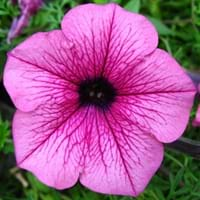Life Span
Perennial
Annual
Type
Grass
Flowering Plants, Shrubs
Origin
North America, Canada, Mexico
South America
Types
Bigleaf hydrangea, Hortensia, Smooth hydrangea, Oakleaf hydrangea, Annabelle
Grandiflora Petunias, Multiflora Petunias, Wave Petunias, Superbell Petunias, Supertunia Petunias
Habitat
Forest edges, Hillside, Woods
Terrestrial
USDA Hardiness Zone
Not Available
9-10
AHS Heat Zone
9*1
Not Available
Sunset Zone
1a, 1b, 2a, 2b, 3a, 3b, 4, 5, 6, 7, 8, 9, 10, 11, 14, 15, 16, 17, 18, 19, 20, 21, 22, 23
not provided
Habit
Upright/Erect
Not Available
Flower Color
Blue, Dark Purple, Light Purple, Red, White
Blue, Pink, Purple, Red, White, Yellow
Flower Color Modifier
Bicolor
Not Available
Fruit Color
Not Available
Not Available
Leaf Color in Spring
Green, Light Green, Blue Green, Gray Green
Golden Green
Leaf Color in Summer
Light Green
Green
Leaf Color in Fall
Red, Green, Orange, Blue Green, Gray Green, Bronze
Green
Leaf Color in Winter
Tan, Sandy Brown
Green
Leaf Shape
Oblovate
Ovate
Plant Season
Spring, Summer, Fall, Winter
Summer
Sunlight
Full Sun, Partial Sun
Full Sun, Partial shade
Type of Soil
Clay, Loam, Sand
Loamy, Sandy
The pH of Soil
Acidic, Neutral, Alkaline
Neutral
Soil Drainage
Average
Well drained
Bloom Time
Early Summer, Summer, Late Summer
Fall, Spring, Summer
Tolerances
Pollution, Soil Compaction
Pollution
Where to Plant?
Container, Ground
Container, Ground, Pot
How to Plant?
Seedlings, Stem Planting
Seedlings, Transplanting
Plant Maintenance
Medium
Medium
Watering Requirements
Not Available
Keep the ground moist but not water-logged, Requires regular watering, Requires watering in the growing season
In Summer
Drought Tolerant, Average Water
Lots of watering
In Spring
Moderate
Moderate
In Winter
Average Water
Average Water
Soil pH
Not Available
Neutral
Soil Type
Not Available
Loamy, Sandy
Soil Drainage Capacity
Not Available
Well drained
Sun Exposure
Not Available
Full Sun, Partial shade
Pruning
Remove damaged leaves, Remove dead branches, Remove dead leaves
Cut or pinch the stems, Do not prune during shooting season, Remove dead or diseased plant parts, Remove deadheads
Fertilizers
All-Purpose Liquid Fertilizer
All-Purpose Liquid Fertilizer
Pests and Diseases
Red blotch
Aphids, Bacterial Blight, Caterpillars, Gray mold, Leaf spot, Powdery mildew, Root rot, Spider mites, Thripes, Verticillium Wilt, Viruses
Plant Tolerance
Pollution, Soil Compaction
Drought
Flower Petal Number
Single
Not Available
Fragrant Bark/Stem
No
Yes
Foliage Texture
Fine
Medium
Foliage Sheen
Not Available
Matte
Invasive
Not Available
No
Self-Sowing
Not Available
Yes
Attracts
Bees, Flies
Butterflies, Hummingbirds
Allergy
Chest tightness, Diarrhea, Dizziness, Nausea, Vomiting
Not Available
Aesthetic Uses
Not Available
Beautification, Bouquets, Showy Purposes
Beauty Benefits
Not Available
Not Available
Edible Uses
Not Available
Unknown
Environmental Uses
Air purification
Air purification
Medicinal Uses
Fever, Kidney problems, Urinary tract problems
Not Available
Part of Plant Used
Flowers, Root
Flowers
Other Uses
Not Available
Showy Purposes
Used As Indoor Plant
Not Available
Yes
Used As Outdoor Plant
Yes
Yes
Garden Design
Not Available
Bedding Plant, Container, Edging
Botanical Name
PANICUM virgatum 'Northwind'
Petunia
Common Name
Northwind Switchgrass, Switchgrass
Petunia
In Hindi
Hydrangea
Petunia
In German
Hortensie
Petunie
In French
Hortensia
Pétunia
In Spanish
Hortensia
Petunia
In Greek
υδραγεία
πετούνια
In Portuguese
Hortênsia
Petúnia
In Polish
Hortensja
Petunia
In Latin
Hibiscus
Petunia
Phylum
Not Available
Streptophyta
Class
Not Available
Magnoliopsida
Order
Not Available
Solanales
Family
Not Available
Solanaceae
Genus
Not Available
Petunia
Clade
Not Available
Angiosperms, Asterids, Eudicots
Tribe
Not Available
Not Available
Subfamily
Not Available
Petunioideae
Number of Species
Not Available
Properties of Northwind Switchgrass and Petunia
Wondering what are the properties of Northwind Switchgrass and Petunia? We provide you with everything About Northwind Switchgrass and Petunia. Northwind Switchgrass doesn't have thorns and Petunia doesn't have thorns. Also Northwind Switchgrass does not have fragrant flowers. Northwind Switchgrass has allergic reactions like Chest tightness, Diarrhea, Dizziness, Nausea and Vomiting and Petunia has allergic reactions like Chest tightness, Diarrhea, Dizziness, Nausea and Vomiting. Compare all the properties and characteristics of these two plants. Find out which of these plant can be used as indoor plant. If you are interested to decorate your house and garden, find out aesthetic uses, compare them and select the plant which will beautify your surrounding. Along with beautification, try comparing medicinal and edible uses of Northwind Switchgrass and Petunia and you can choose the plant having best and most benefits.
Season and Care of Northwind Switchgrass and Petunia
Season and care of Northwind Switchgrass and Petunia is important to know. While considering everything about Northwind Switchgrass and Petunia Care, growing season is an essential factor. Northwind Switchgrass season is Spring, Summer, Fall and Winter and Petunia season is Spring, Summer, Fall and Winter. The type of soil for Northwind Switchgrass is Clay, Loam, Sand and for Petunia is Loamy, Sandy while the PH of soil for Northwind Switchgrass is Acidic, Neutral, Alkaline and for Petunia is Neutral.
Northwind Switchgrass and Petunia Physical Information
Northwind Switchgrass and Petunia physical information is very important for comparison. Northwind Switchgrass height is 150.00 cm and width 90.00 cm whereas Petunia height is 5.00 cm and width 2.50 cm. The color specification of Northwind Switchgrass and Petunia are as follows:
Northwind Switchgrass flower color: Blue, Dark Purple, Light Purple, Red and White
Northwind Switchgrass leaf color: Green, Light Green, Blue Green and Gray Green
Petunia flower color: Blue, Pink, Purple, Red, White and Yellow
- Petunia leaf color: Golden Green
Care of Northwind Switchgrass and Petunia
Care of Northwind Switchgrass and Petunia include pruning, fertilizers, watering etc. Northwind Switchgrass pruning is done Remove damaged leaves, Remove dead branches and Remove dead leaves and Petunia pruning is done Cut or pinch the stems, Do not prune during shooting season, Remove dead or diseased plant parts and Remove deadheads. In summer Northwind Switchgrass needs Drought Tolerant, Average Water and in winter, it needs Average Water. Whereas, in summer Petunia needs Lots of watering and in winter, it needs Average Water.




